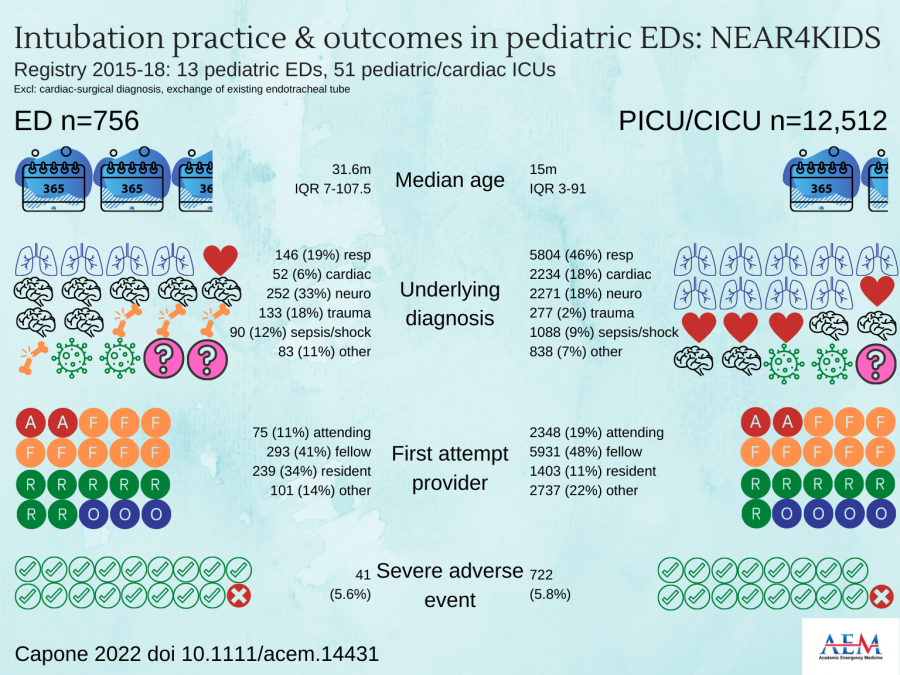AEM Publishes Report on Pediatric Intubation in Emergency Departments
Intubation Practice and Outcomes in Pediatric EDs: NEAR4KIDS
While the characteristics of tracheal intubation vary between pediatric emergency departments and intensive care units, the results are similar.
DES PLAINES, ILLINOIS, UNITED STATES, Apr 13, 2022 /EINPresswire.com/ — Although the characteristics of tracheal intubation (TI) vary between pediatric emergency departments (ED) and intensive care units (ICUs), the results are similar. That concludes the study titled Intubation practice and results among pediatric emergency departments: A report from the National Emergency Airway Registry for Children (NEAR4KIDS), to be published in the April 2022 issue of Academic Emergency Medicine (AEM). , a peer-reviewed journal of the Society for Academic Emergency Medicine (SAEM).
The study’s lead author is Christine A. Capone, MD, MPH, is a pediatric cardiologist in the pediatric intensive care unit of medicine in the division of pediatrics at Steven and Alexandra Cohen Children’s Medical Center, New Hyde Park, New York. The results of the study are discussed in a recent AEM podcast.
The primary objective of this study was to describe the patient, caregiver, and practice characteristics of ED TIs within the multi-center National Emergency Airway Registry for Children (NEAR4KIDS) registry as opposed to TIs in the ICU. The study found that shock and restricted mouth opening were independently associated with adverse TI events in the emergency room.
TI for critically ill or injured children is a life-saving yet risky procedure, occurring on average once every five days in pediatric emergency rooms. These patients may have acute physiological disturbances, trauma and/or a full stomach, all of which may contribute to an unpredictable clinical course. Because TIs are relatively uncommon in emergency rooms, health care providers may have difficulty maintaining procedural skills.
Multicenter, comprehensive analysis of procedural indications, risk factors, caregiver characteristics, and equipment choice for pediatric ED TIs has not yet been performed. This data is essential for identifying areas where patient safety and procedural success can be optimized. Examples of quality improvement work in respiratory management in children exist in the ICU and emergency room; however, an understanding of their similarities and differences is essential for replication and promotion of past successes.
†
ABOUT ACADEMIC EMERGENCY HISTORY
Academic Emergency Medicine, the monthly journal of the Society for Academic Emergency Medicine, offers the best in peer-reviewed, groundbreaking original research relevant to emergency medicine practice and research. The above study has been published open access and can be downloaded via the DOI link: 10.1111/acem.14431. Journalists wishing to interview the authors may contact Tami Craig at tcraig@saem.org.
ABOUT SOCIETY FOR ACADEMIC EMERGENCY HISTORY
SAEM is a 501(c)(3) non-profit organization committed to improving care for the acutely ill and injured patient by leading the advancement of academic emergency medicine through education and research, advocacy, and professional development . For more information, visit saem.org.
Tami Craig
LEAVE
+1 847-813-5734
email us here
Visit us on social media:
facebook
Twitter
LinkedIn
You just read:
News delivered by
April 13, 2022, 13:00 GMT
EIN Presswire’s priority is source transparency. We do not allow opaque customers and our editors try to be careful about removing fake and deceptive content. As a user, if you see something we missed, please bring it to our attention. Your help is welcome. EIN Presswire, Everyone’s Internet News Presswire™, tries to define some of the limits that are reasonable in today’s world. Please see our editorial guidelines for more information.
Submit your press release


Comments are closed.